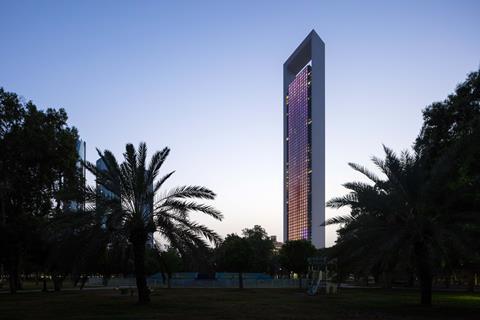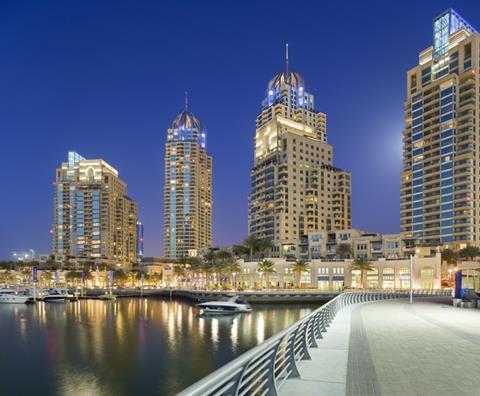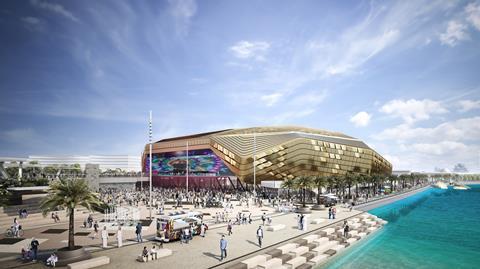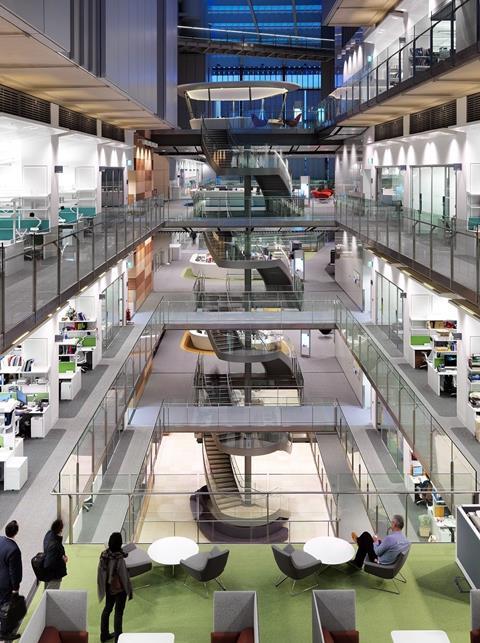After 20 years in the Middle East, Daniel Hajjar moved to the UK, where, eight years on, he finds the political ‘flakiness’ of the country has made it an infuriating place to build. Thomas Lowe reports

It is 3pm on a Friday afternoon and HOK’s Fitzrovia office is nearly deserted. In the distance, a sole staff member taps away on a computer surrounded by empty chairs.
Lights are already dimmed in many of the office rooms – a fairly typical scene in the capital these days. A model of HOK’s design for Barcelona FC’s new Palau Blaugrana Arena gives visitors something to gaze at while waiting at reception.
Then, charging out of a lift, comes Daniel Hajjar, HOK’s managing principal of Europe, the Middle East and Africa (EMEA), with a big, meaty handshake and a greeting which booms up to the rafters. Staff are only expected to come in on Wednesdays and Thursdays, he explains, partly because HOK has developed such a streamlined remote working culture that was ready to go some three years before the first covid lockdown. It was not the threat of a pandemic which prompted Hajjar to buy every staff member a laptop but a terrorist attack in Borough Market which resulted in a large part of London Bridge being roped off by police.
“So we said, what happens if, you know, this entire area is closed off? We can’t get into the studio, how are we going to work, et cetera, et cetera. So at the time, we just sort of said, you know what? The easiest thing is to get everyone a laptop,” he says.
It meant that the practice suffered almost no downtime when lockdown hit because the office had already tested their remote IT systems “about six times”.
The quieter surroundings do not seem to faze Hajjar. He is a native of Edmonton, Canada, the northernmost major city in North America, where temperatures can drop below -20C in winter and summers are plagued by mosquitoes “big enough to open the screen door”. It is a “prairie town”, he says, nearly a “full continent” away from the nearest population centre.
Now living and working in the bustling heart of London, does he ever find himself yearning for the big open spaces? “I keep telling everyone, you can’t take the prairie out of me, no matter what you do,” he admits.
He relocated to the capital in 2015 after 20 years working in the Middle East, where he set up HOK’s office in Dubai. Although he spent “most of 2014” on a plane travelling between the two cities, he says he did not really know what to expect before he moved with his family to London. But he did not think it was “going to be as complex as it is to do work” in the city.

“There are so many intricacies in terms of the planning, in terms of land tenure. It’s a leasehold? It’s a freehold? And the freeholder can tell you what to do? I was never really used to that because in Canada, frankly, you buy a plot of land and it’s yours.”
He says he appreciates London for what it is. “It’s a terrific city. It’s a fantastic city. It’s got an energy that frankly, when people ask me, ‘New York or London?’ I say London any day of the week because I just find New York’s too much in your face.”
And he says that the planning system in New York is “20 times worse” than in London because of strict rules on protecting daylight and a predisposition of firms and organisations linked to a project to sue each other at every opportunity.
But it is the history of London, as much of a blessing it might be for tourists or locals, that can be frustrating for builders. “You put a shovel in the ground, and everyone’s going like, ‘oh, wait a minute, we found bones. Stop the diggers. We’ve got to do the analysis.”
Hajjar’s journey to becoming a regional boss at one of the world’s biggest architectural practices started in Edmonton, watching his father, an immigrant from Lebanon who worked on the railway, working in his garage. “He was a tinkerer kind of guy, he’d go into his garage or workshop, and if something was broken, he’d figure out a way to fix it.

“So I kind of grew up watching this. And, if he needed that little tool to do something, he would make it himself.”
Hajjar says the passion, for him, is still “in the making” of a design – “the actual process in making it happen. Putting them together is still a passion of mine.”
At school – which was across the road from the school where another Edmonton native, former Bank of England governor Mark Carney, went – Hajjar had wanted to be a draughtsman. He had turned his sights to architecture at the age of 14 after walking into a small local practice, where he worked over a summer for the minimum wage and “was happy as a clam”. The principals there persuaded him to study architecture, which he did in Winnipeg in the 1980s.
After graduating he set up his own practice with two friends, working for a few years on social housing and pharmaceutical projects before they went their separate ways. Finding himself without any commitments, he decided to take a gamble and work overseas, going down to the central library and sending out job applications using a fax machine.
He ended up landing a job with Pan Arab Consulting Engineers (PACE), one of the biggest practices in the Middle East, and moved to Kuwait in 1994 as the country was rebuilding after the Gulf War. Later, one of his clients in Dubai was Emaar Properties, at the time only a 12-person development outfit. Ten years down the line the firm built the Burj Khalifa, the tallest building in the world. But back then Dubai was still little more than a town, rapidly developing in all directions.

“There were just vast tracts of empty land,” he says. “Nothing. You can’t camp on the beaches anymore, but we used to pitch a tent and camp over the weekend, and nobody would say anything to you.”
His first major project in Dubai was the first six buildings on what is now the marina, a scheme which established Emaar as a serious commercial developer. He went on to work across the region on projects including an oil company headquarters in Abu Dhabi and a research hub in Saudi Arabia.
He joined HOK in 1999 and set up the firm’s Dubai office in 2000 before being appointed EMEA principal in 2010.
The practice was appointed to draw up concept designs for a module on The Line, the outlandish project to build a linear city in Saudi Arabia consisting of two parallel structures 500m high and 170 km long. The work consisted of looking at how a university campus could be stacked vertically.

HOK is also working on “three or four” smaller schemes on the controversial Neom project, of which The Line is a part, although Hajjar remains tight-lipped on the details.
The scale and speed of construction in the Middle East, and the vast expanse of land in his native Canada, can partly explain Hajjar’s sense of frustration at working conditions in the UK. He says getting projects completed in this country is the biggest problem facing the UK built environment sector, not just because of the planning system but because of a lack of political consistency.
The past 10 years under the Conservative government has been “totally flaky,” he says, particularly on promises to build 300,000 homes a year, a target which has all but been abandoned, and 40 hospitals by 2030, a pledge which was watered down earlier this year.
“Nobody believes them anymore. If I keep telling you, you know what… I’ll build your house tomorrow, and a year passes. And you’re going, Wait a minute, you said that for 365 times, and I don’t actually see a foundation in place. Who’s gonna believe them anymore? You’ve lost credibility.
“Don’t make the promise if you’re not going to deliver it, especially when it comes to healthcare, education, and any kind of security for their families. Just don’t do that to people.”

Daniel Hajjar CV
Born in Edmonton, Canada
1981-87 Undergraduate and Masters degrees in architecture at University of Manitoba, Canada
1988 Sets up architectural practice with friends
1994 Joins Pan Arab Consulting Engineers (PACE) and moves to Kuwait. Works on the Bayan Palace, the Emir of Kuwait’s main residence, among other schemes.
1999 Joins HOK and sets up Dubai office. Works on masterplan for Dubai marina, the design and delivery of global HQs for Zadco/Gasco and ADNOC in Abu Dhabi among other schemes
2010 Appointed to HOK board of directors as managing principal EMEA. Moves to London in 2015. Behind the design and delivery of the Francis Crick Institute which was opened by the Queen in November 2016.
Another example is the government’s botched introduction of rules to require second staircases in residential buildings taller than 18m, which have been announced without any accompanying design guidance. Although housing is not HOK’s core market, the practice has still been caught up in the same confusion which has disrupted much of the industry over the past year.
“We were talking about it last week, and our technical principal, who’s kind of responsible for keeping up to date with all of that stuff, said, ‘Well, we’re really not sure about how it actually gets implemented’. And I’m like, ‘what do you mean, you’re not sure’?
“All of a sudden, it’s turned into this whole debacle and nobody really knows what it’s about.”
The geography of both Canada and the Middle East makes for a very different planning context compared with the UK. But if any government is serious about delivering on construction promises, taking a bit more time to listen to people like Hajjar and the firms doing the work would be a good place to start.



























No comments yet